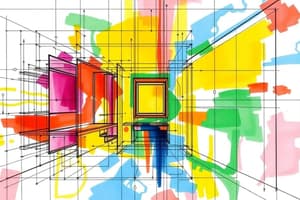Podcast
Questions and Answers
What is orthographic projection?
What is orthographic projection?
The graphic representation of the true shape of an object using two or more views on planes at right angles.
Which planes are involved in orthographic projection?
Which planes are involved in orthographic projection?
- Frontal Plane
- Horizontal Plane
- Profile Plane
- All of the above (correct)
Name the six regular views of an object.
Name the six regular views of an object.
Front view, top view, right side view, left side view, rear view, bottom view.
What dimension is measured from left to right?
What dimension is measured from left to right?
In orthographic projection, all lines can be projected longer than their true length.
In orthographic projection, all lines can be projected longer than their true length.
What happens to lines perpendicular to a plane of projection?
What happens to lines perpendicular to a plane of projection?
Which views are aligned vertically in orthographic projection?
Which views are aligned vertically in orthographic projection?
Flashcards
Orthographic Projection
Orthographic Projection
A graphical representation of an object's true shape using multiple views on perpendicular planes, assuming the observer is directly in front.
Frontal Plane
Frontal Plane
The plane that projects the front view of an object, showing its primary shape and features.
Horizontal Plane
Horizontal Plane
The plane that projects the top view of an object, showing its layout from above.
Profile Plane
Profile Plane
Signup and view all the flashcards
Width
Width
Signup and view all the flashcards
Depth
Depth
Signup and view all the flashcards
Height
Height
Signup and view all the flashcards
Study Notes
Orthographic Projection Overview
- Orthographic projection graphically represents an object's true shape through two or more views on perpendicular planes.
- Assumes the observer is directly in front of the object, where the line of sight is perpendicular to the projected view.
Specific Objectives
- Explain the concept of orthographic projection.
- Identify the different planes of projection: Frontal, Horizontal, and Profile.
- Describe and apply standard line practices for orthographic projection.
- Draw the necessary views based on principles of orthographic projection.
Planes of Projection
- Frontal Plane: Projects the front view of an object.
- Horizontal Plane: Projects the top view of an object.
- Profile Plane: Projects the side views of an object.
Regular Views of an Object
- Six regular views exist:
- Front View: Shows the characteristic shape; irregular shapes outline this view.
- Top View: Located above the front view.
- Right Side View: Located to the right of the front view.
- Left Side View: Located to the left of the front view.
- Rear View: Found at the back of the front view.
- Bottom View: Located below the top view.
- Principal views focus on the front, top, and right-side views.
Three Space Dimensions
- Width: Measured from left to right between two profile planes.
- Depth: Measured from front to rear between two frontal planes.
- Height: Measured from bottom to top between two horizontal planes.
- Each view displays only two of these dimensions (e.g., front view shows width and height).
Principles of Orthographic Projection
- Points project as points in all planes.
- Lines parallel to a plane appear in true lengths; perpendicular lines appear as points.
- Inclined lines appear foreshortened, and no line may project longer than its true length.
- Surfaces parallel appear in true size and shape; perpendicular surfaces appear as edges.
- Surfaces inclined retain shape but are portrayed smaller.
- Top view is drawn directly above the front view; both views should be vertically aligned.
- The depth of both top and side views remains equal.
Selection of Views
- Orthographic projection aims to accurately describe an object's shape using different views.
- Although objects can have six views, not all are necessary to describe shape.
- Select views based on:
- Characteristic shapes or outlines that best represent the object.
- Normal use positioning, whether vertically or horizontally aligned.
- Views that minimize hidden lines for clarity and ease of understanding.
Studying That Suits You
Use AI to generate personalized quizzes and flashcards to suit your learning preferences.




